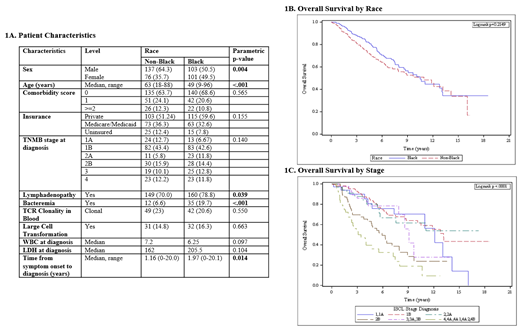Abstract
Introduction
Black (B) patients with Mycosis fungoides and Sézary Syndrome (MF/SS) have inferior survival and distinct clinical presentations, including many high risk features compared to non-black (NB) patients with MF/SS in large registry studies from the United States. We sought to characterize clinical differences in presentation, treatment, and outcomes to identify drivers of disparities among B patients with MF/SS.
Methods
We performed a retrospective review of 417 patients with MF/SS diagnosed between 1990 and 2020 at 6 academic institutions in the United States that serve populations with large numbers of Blacks and minorities. Patients with pathologic review and a confirmed histopathologic diagnosis of MF or SS with a stage >1B as their highest TNMB stage were eligible for inclusion. The primary objective was to assess differences in clinical characteristics, treatment patterns, and survival between B and NB patients. Clinical variables included demographics, insurance, zip code, tumor characteristics, and treatment. Descriptive analysis was performed for each variable. Comparison between B and NB patients utilized ANOVA for numerical covariates and chi-square test or Fisher's exact test for categorical covariates. Kaplan-Meier curves for OS were generated, and subgroups were analyzed separated.
Results
Among 417 patients, 204 (48.9%) were Blacks, 196 (47.0%) were White, and (4.1%) were other races (8 Asian, 5 unknown, 4 Hispanic). The diagnosis was MF in 366 (87.8%), SS in 47 (11.3%), and other 4 patients. Stage at diagnosis was available for 384 patients. 37 (9.6%) were stage 1A, 165 (43%) were stage 1B, 34 (8.9%) were stage 2A, 58 (15.1%) were stage 2B, 44 (11.5%) were stage 3, and 46 (12%) were stage 4 at diagnosis. The median survival of the whole cohort (n=417) was
B patients were younger (median 50.1 years in B vs. 60.5 in NB, p<0.001), more often female (49.5% in B; 35.7% in NB, p=0.004), had higher rates of reported lymphadenopathy (78.5% vs. 70%, p=0.039), longer delays from symptom onset to diagnosis (2.0 years in Black vs. 1.2 years in NB, p=0.014), and higher rates of bacteremia at any time in their disease course (19.7% in Black, vs. 6.6% in NB, P< 0.001) compared to NB patients. There was no difference in insurance status (private, Medicare/Medicaid, or uninsured) or comorbidities by race. There was also no differences in overall TNMB stage at diagnosis (p=0.14) compartment stage, or highest stage (p=0.076). Progression to a higher T, N, M, or B stage occurred at similar frequencies in B and NB patients (n=83 (43.2%) in Black and n=73 (38.8%) in NB, p=0.38). Time to first therapy, time to systemic therapy, or total lines of therapy also did not differ by racial group. A greater fraction of B compared to NB patients received systemic therapy but this did not reach statistical significance (72.6% in Black vs. 62% in NB, p=0.060). There was no difference in large cell transformation at any point, or white blood cell count (WBC), lactate dehydrogenase (LDH), or T-cell receptor (TCR) clonality in skin/blood at diagnosis.
On univariate analysis, race was not associated with survival; the median survival was 10.5 years (95% CI 8-13.2) in B patients and 10.9 years (95% CI 7.2-14.1) in NB patients. Covariates associated with inferior survival included older age (p<0.001), number of comorbidities (p< 0.001), bacteremia (p< 0.001), higher overall TNMB stage, higher individual T, N, M and B stage, progression to a higher N or M stage, positive TCR in the blood, WBC value, and LDH value. Insurance status and year of diagnosis (prior to 2010, vs. following 2010) were not associated with survival. On multivariate cox proportional hazard model, age at diagnosis, comorbidities, extra-cutaneous disease, bacteremia, TNMB stage at diagnosis, and progression to a higher nodal stage remained statistically significant for survival.
Conclusions
We present the first multicenter analysis of racial disparities in MF/SS, with nearly 50% B patients. B patients had distinct presentations, delay in diagnosis, and higher rates of bacteremia compared to NB patients. In contrast to US-registry studies, there was no difference in survival between B and NB patients. This finding could be explained by access to academic centers and/or higher rates of insurance coverage among B patients in our cohort. Additional analyses will be updated at the time of the presentation.
Allen: ADC Therapeutics: Consultancy; Kyowa Kirin: Consultancy; Secure Bio: Consultancy. Mehta: Seattle Genetics; Incyte; TG Therapeutics: Consultancy; Seattle Genetics; Incyte; TG Therapeutics: Membership on an entity's Board of Directors or advisory committees, Speakers Bureau; Affirmed; Kite/Gilead; Roche-Genetech; Celgene/BMS; Oncotartis; Innate Pharmaceuticals; Seattle Genetics; Incyte; Takeda; Fortyseven Inc/Gilead; TG Therapeutics; Merck; Juno Pharmaceuticals/Bristol Myers Squibb: Research Funding. Huen: Rhizen: Research Funding; Elorac: Research Funding; Kyowa Kirin: Research Funding; Tillium: Research Funding; Innate: Research Funding; Galderma: Research Funding; Miragen: Research Funding. Porcu: Viracta: Honoraria, Membership on an entity's Board of Directors or advisory committees, Research Funding; Innate Pharma: Honoraria, Membership on an entity's Board of Directors or advisory committees, Research Funding; BeiGene: Membership on an entity's Board of Directors or advisory committees, Research Funding; Incyte: Research Funding; Daiichi: Honoraria, Research Funding; Kiowa: Honoraria, Membership on an entity's Board of Directors or advisory committees, Research Funding; Spectrum: Consultancy; DrenBio: Consultancy.


This feature is available to Subscribers Only
Sign In or Create an Account Close Modal